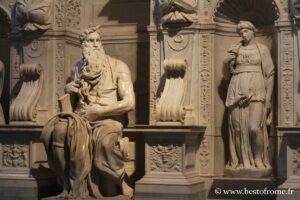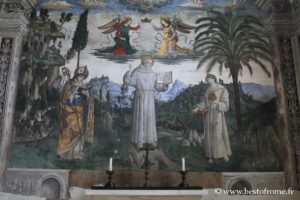The Renaissance (Rinascimento in Italian) is a period of great cultural change in Europe that began in Italy at the end of the 14th century, and in the same country developed until the beginning of the 16th century. It constitutes the transition between medieval and modern Europe.
It is in literature that this movement took its source, with in particular intellectual patronage and an interest in the rediscovery of classical culture and antiquity. It concerned primarily the upper social classes.
It was in Tuscany that the Renaissance emerged, around Florence and Siena, quickly impacting Rome where it was maintained by the Papacy.
It was only at the end of the 15th century that the movement spread to the whole of Italian society and culture. This was the time of its heyday, although the country was plagued by chaos, under foreign incursions and internal struggles, between factions and between cities, especially between supporters of the Pope and those of the Holy Roman Empire.
Beyond Italy, the ideas of the Renaissance spread throughout the rest of Europe, with the development of the Spanish, French, English or Nordic Renaissance. These movements each had their own temporalities and rhythms, with in each region their own characteristics and styles, with the impulse and influence of stays of great masters and great artists.
- The Moses of Michelangelo
- Chapel of Saint-Bernardin by Pinturicchio in Santa Maria in Aracoeli
In Italy and Rome in particular, the Renaissance was embodied in major works, in art in particular, with great names such as Michelangelo (in the Sistine Chapel in particular), Raphael (with the rooms of the apartments of Julius II), and Leonardo da Vinci. It took shape, for example, in St Peter’s Basilica in Rome.
This movement also had the contribution of many foreign artists who came to Rome to learn, but who left their own imprint and food the evolution of the Renaissance. First, let’s mention Fra Angelico, Ghirlandaio, Benozzo Gozzoli, Melozzo da Forlì, Piero della Francesca, Mantegna. Then emerged Botticelli, Signorelli and Perugino (who all three worked in the Sistine Chapel), and then Antoniazzo Romano, Filippino Lippi, Pinturicchio. Lorenzo Lotto, Sodoma and Sebastiano Del Piombo also came to Rome.
Pages culture and Renaissance in Rome
- Raphael in Rome: a genius of the RenaissanceRaffael (1483-1520), eine ikonische Figur der Renaissance, hat in Rom einen bleibenden Eindruck im künstlerischen und architektonischen Bereich hinterlassen, wie z. B. seine bedeutenden Fresken im Vatikan und ...
- Michelangelo in RomeMichelangelo (1475–1564), an iconic artist of the Renaissance, excelled in sculpture, painting, architecture, and poetry. He developed a style characterized by anatomical realism and expressive intensity. In Rome, ...
Pages monuments and Renaissance
- Roman churches and basilicasThe section is dedicated to the iconic basilicas and churches of Rome, among the most significant and fascinating in a city that counts over 400 of them. Beyond ...
- Saint Peter’s BasilicaHeart of the Vatican, the Saint Peter's Basilica is a special and essential building in the Christian world, built on the tomb of Saint Peter around 320 AD. ...
- Sistine ChapelThe Sistine Chapel, located in the heart of the Vatican, is famous for its monumental frescoes, including the vault and Judgment Day by Michelangelo. This masterpiece of the ...
- Remarkable palaces in RomeThe article presents a selection of historic palaces in the city, reflecting its rich architectural heritage. Among them, the Quirinal Palace served as a residence for the popes ...
- Capitoline SquareAt the top of the Capitol hill, which was the spiritual heart of ancient Rome, the square was redesigned by Michelangelo in the 16th century, creating a harmonious ...
Pages museums and Renaissance
- Listo of museums of Rome by themeThe various museums to discover in Rome and private galleries, including collections of antiques, thematic, modern and contemporary. The four museums described in the Great Museums of Rome page ...
- Vatican Museums : visit and informationsIn addition to the famous Sistine Chapel and the Raphael's Rooms, the Vatican Palaces house the collections of the twelve Vatican Museums, forming one of the largest ...











